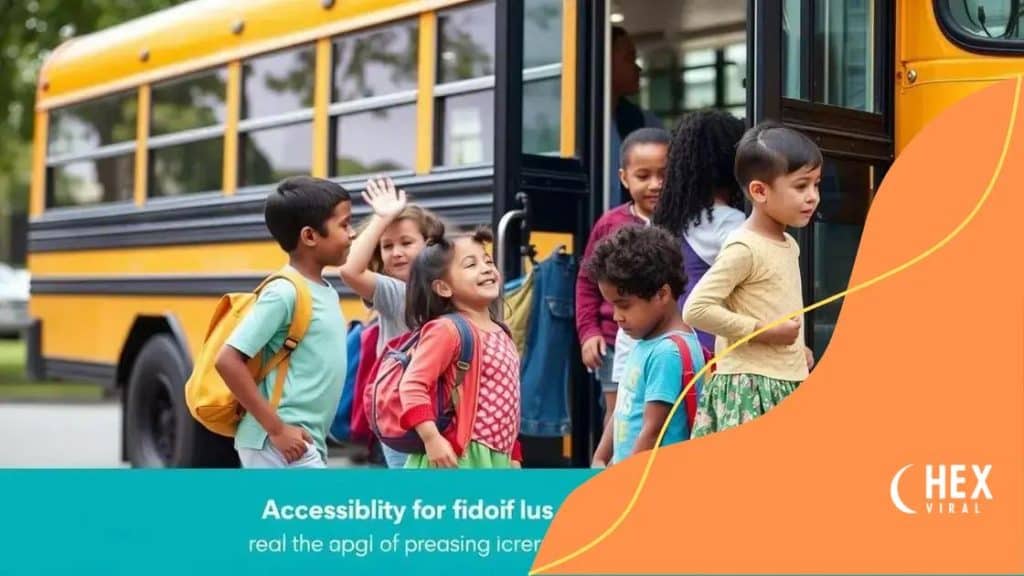Accessible school transportation funding: what you need to know

Accessible school transportation funding is essential for ensuring that all students, including those with disabilities, have reliable and safe transportation to school, promoting attendance and equal educational opportunities.
Accessible school transportation funding plays a vital role in helping ensure that every child gets to school safely and on time. Have you ever wondered how schools manage to provide this essential service, especially for those with special needs? In this article, we’ll dive into the importance of funding for transportation and how it impacts students’ lives.
Understanding accessible school transportation
When we talk about accessible school transportation, we are referring to the various means that ensure all students can safely reach their schools. This includes strategies, vehicles, and funding that address the needs of students with disabilities.
Understanding the significance of accessible school transportation is crucial for promoting inclusivity in education. Many students face barriers that prevent them from attending school simply because transportation options are inadequate. By highlighting effective solutions, we can pave the way for enhanced access.
Importance of Accessibility
Accessibility in school transportation is vital for various reasons:
- It promotes equality by providing equal opportunities for all students.
- Accessible transportation reduces absenteeism among students with disabilities.
- It allows families to depend on reliable and safe transportation options.
With the right funding, schools can invest in accessible buses and training for drivers, ensuring that every child has the chance to succeed academically. Additionally, it fosters a sense of belonging among students, helping them feel included in their school community.
In order to better understand the barriers faced by students who need accessible transportation, it is essential to listen to their experiences. Many families report stress concerning logistics and safety. Poorly designed transportation systems may lead to longer travel times and a lack of comfort for the students. By advocating for change, communities can collaborate on creating a better system.
Implementing Solutions
To enhance accessibility, there are several solutions that can be considered:
- Invest in specialized training for drivers.
- Introduce more wheelchair-accessible vehicles.
- Develop partnerships with local transportation agencies.
Incorporating technology can also play a significant role in improving school transportation. Apps that track bus locations or provide real-time updates can help families and students plan better, reducing anxiety about travel.
The ultimate goal is to create a system where accessible school transportation is the norm rather than the exception. This requires a collective effort from schools, parents, and policymakers to ensure that every child’s educational journey begins with a safe and reliable ride to school.
Key benefits of school transportation funding
School transportation funding is essential for creating an inclusive educational environment. By investing in reliable transportation, schools ensure that all students have access to their education. This funding not only improves attendance but also significantly enhances the overall educational experience for families and students alike.
One of the main benefits of school transportation funding is its impact on student attendance. When students have a safe and dependable way to get to school, they are less likely to miss classes. This consistency can lead to better academic performance.
Improved Student Safety
Transportation funding allows schools to invest in safer vehicles and better routes. Ensuring that buses are equipped with safety features, such as seat belts and proper maintenance, can significantly lower accident risks. Additionally, students are less likely to walk in unsafe areas, which promotes a safer environment overall.
- Funding for trained drivers who understand student needs.
- Investments in hazard-free bus stops.
- Implementation of tracking systems for added security.
Another vital benefit of school transportation funding is its contribution to community engagement. When schools provide reliable transportation options, families in the community are more inclined to participate in school events and activities. This engagement fosters a stronger sense of community and support for students and their education.
Furthermore, properly funded transportation systems can also reduce traffic congestion around schools. When more students use school buses instead of personal vehicles, this leads to fewer cars on the road during peak hours. This positive impact on traffic can enhance the environment and improve air quality.
Access to Extracurricular Activities
Finally, funding for school transportation ensures that students can participate in extracurricular activities. Access to sports, clubs, and events is crucial for a well-rounded education. By providing reliable transportation, schools enable students to explore their interests outside traditional classroom settings.
- Encourages participation in sports and arts programs.
- Supports field trips that enhance learning.
- Strengthens team-building experiences among students.
With all these advantages, it becomes clear that funding for school transportation is not just an expense; it is a wise investment in the future of students and communities.
Challenges in securing transportation funding

Securing transportation funding for schools comes with its own set of challenges. Various factors affect how funds are allocated, making it difficult for schools to have consistent and reliable transportation options. The complexity of the funding process can create hurdles for administrators trying to meet the needs of all students.
One major challenge is understanding the funding sources. There are multiple avenues for funding, including state and federal programs, grants, and local taxes. Each source has its own requirements and application processes, which can be overwhelming for school districts.
Limited Awareness
Many school districts struggle with limited awareness of available funding opportunities. Often, school officials may not know how to identify or apply for these funds. This gap in knowledge can lead to missed opportunities that could significantly improve school transportation services.
- Training staff on funding application processes.
- Developing partnerships with experienced organizations.
- Utilizing resources like online databases for funding sources.
Another challenge in securing transportation funding is competition. Schools often compete against each other for the same pool of funds. This competition can create disparities between schools in different districts. The schools that are more adept at navigating the application processes tend to receive more funding.
In addition to competition, budget constraints present another significant barrier. School budgets are typically tight, and transportation is often seen as a lower priority compared to educational resources. Limited funding can result in inadequate transportation options, which can hinder students’ ability to attend school regularly.
Regulatory Hurdles
Regulatory requirements can also complicate the funding process. Schools must adhere to various state and federal regulations that dictate how transportation funds can be used. These regulations may force schools to allocate funds in ways that do not directly benefit student transportation needs.
- Understanding compliance requirements.
- Maintaining records for audits and evaluations.
- Aligning transportation goals with regulatory guidelines.
By recognizing these challenges, schools and communities can work together to advocate for more accessible funding opportunities. Creating awareness about the importance of reliable school transportation can lead to better support from stakeholders and policymakers.
How to apply for funding programs
Applying for funding programs for school transportation can be an exciting yet challenging process. Understanding how to navigate this landscape is essential for obtaining the support needed to enhance student access. The right approach can open doors to funding that significantly improves transportation services.
The first step in applying for funding is to identify available programs. There are numerous federal, state, and local programs designed to help schools with transportation needs. Searching online for grants specific to education and transportation can yield many results. Additionally, local school districts may have resources or connections that can assist in locating these opportunities.
Prepare Necessary Documentation
Before submitting an application, it’s crucial to gather all necessary documentation. Many funding programs require specific information, such as budget forecasts and data on student needs. Be sure to:
- Compile current transportation data, including ridership statistics and safety records.
- Prepare a clear budget that outlines how the funds will be used.
- Include supporting letters from community stakeholders that highlight the importance of reliable transportation.
Once you have your documentation in place, it’s important to develop a persuasive narrative. This narrative explains the need for funding and how it will benefit students. Clearly outline how improved transportation will lead to better attendance and safety for students.
Submit the Application
After preparing all materials, the next step is to submit your application. Be mindful of deadlines, as missing them can result in lost opportunities. Keep a checklist of requirements and follow up to ensure that the application was received. Many organizations allow for submission through online portals, which can streamline the process.
Following submission, remain proactive by staying engaged with funding agencies. They may require additional information or updates about your request. Communicating effectively can improve your chances of securing funding. It’s also beneficial to network with others who have successfully obtained funding in the past, as they can provide insights and tips that can strengthen your application.
With persistence, organization, and a clear understanding of how to apply for transportation funding, schools can increase their chances of receiving the financial support necessary to enhance their transportation services.
Real-life success stories
Real-life success stories can provide inspiration and valuable lessons when it comes to accessible school transportation. These examples highlight how funding and innovative solutions have transformed transportation systems, making education more accessible for all students.
One notable success is a school district in California that secured federal funding to upgrade its transportation fleet. By investing in wheelchair-accessible buses, the district ensured that students with disabilities could travel comfortably and safely to school. This change significantly improved attendance rates among these students, demonstrating the positive impact of adequate funding.
Community Involvement
Another inspiring story comes from a community initiative in New York City. Parents and local organizations partnered with the school district to advocate for better transportation options. They organized meetings and shared their concerns, which led to increased funding for safe bus routes. As a result, more families felt confident sending their children to school, knowing they had consistent and reliable transportation.
- The collaboration fostered a sense of shared responsibility.
- Parents became active participants in the decision-making process.
- They established a sustainable model for ongoing communication with school officials.
In another example, a small rural district in Texas faced challenges due to long distances between homes and schools. They implemented a carpool system, where families could volunteer to drive students who lived nearby. With support from local businesses and community leaders, they secured additional funding to create a transportation app that coordinated rides. This system increased safety and reduced the need for funding for traditional buses while fostering community ties.
Positive Outcomes
These stories demonstrate the tangible benefits of successfully securing funding and community support for transportation. Not only do they improve accessibility, but they also enhance the educational experience for students. Schools that prioritize transportation funding often see increased participation in extracurricular activities, boosting overall student engagement.
Furthermore, real-life success stories encourage other districts and communities to pursue similar initiatives. By sharing these experiences, schools can learn from one another and adapt strategies that have proven effective, ultimately leading to a more inclusive educational environment for all.
FAQ – Frequently Asked Questions About Accessible School Transportation Funding
What are the main benefits of accessible school transportation funding?
Accessible transportation funding ensures that all students, including those with disabilities, can safely reach school. It also improves attendance and promotes inclusivity.
How can communities advocate for better school transportation?
Communities can advocate by organizing meetings, raising awareness of transportation issues, and collaborating with school districts to push for necessary funding.
What challenges do schools face in securing transportation funding?
Schools often encounter challenges such as competition for funds, limited awareness of available programs, and budget constraints that prioritize other resources.
What steps can schools take to apply for transportation funding?
Schools should identify available funding programs, prepare necessary documentation, craft a persuasive narrative, and submit applications by deadlines while maintaining communication with funding agencies.






